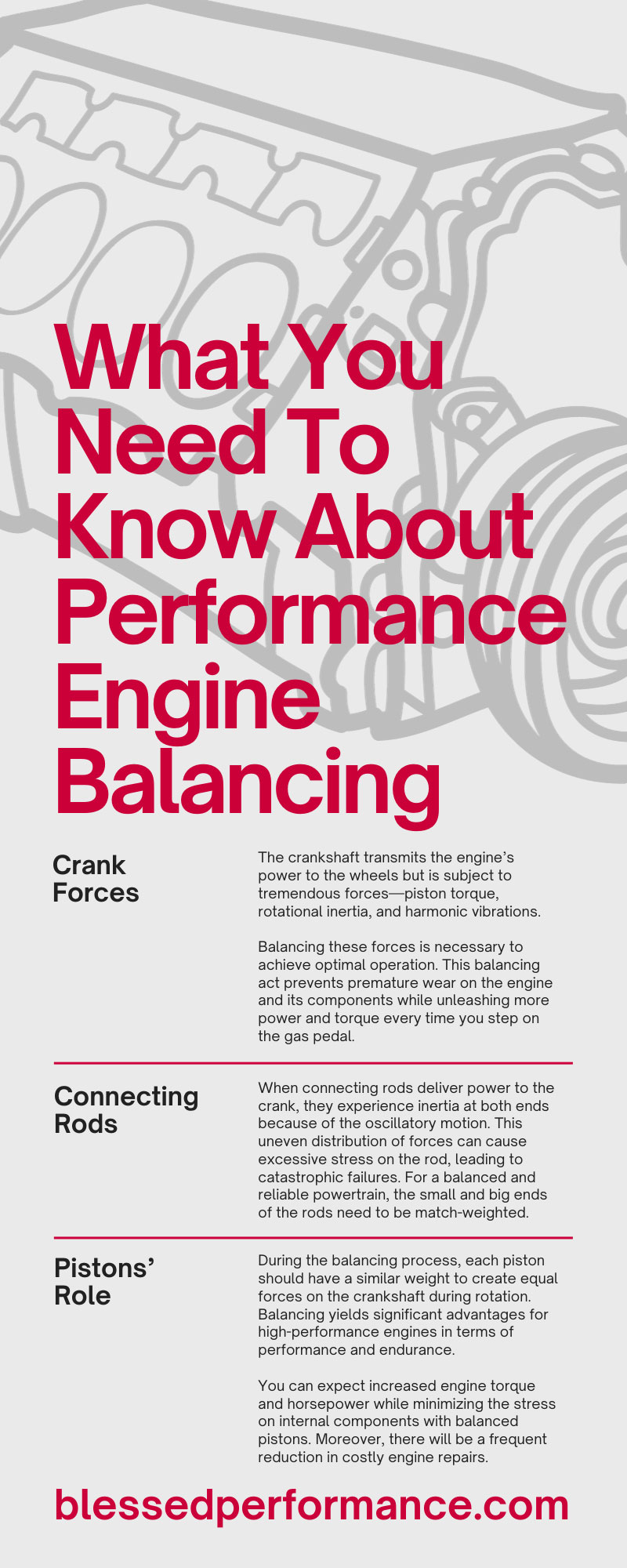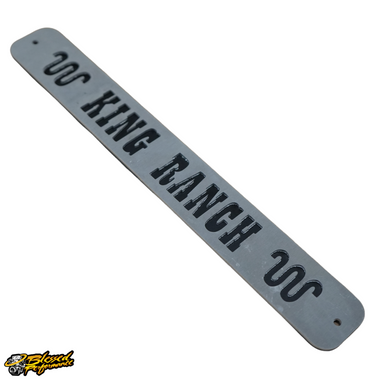What You Need To Know About Performance Engine Balancing
Estimated 0 min read
A high-performance engine unleashes the beast within your vehicle, delivering a convincing and thrilling driving experience. But what stands between you and an engine that purrs like a wildcat?
Engine balancing.
This crucial process eliminates the imbalances in the rotating assembly that can decrease your engine’s efficiency, power output, and longevity. Today, we’ll take you on a grand tour of all there is to know about performance engine balancing to make your beast unmatched on the road.
Crank Forces
Let’s begin with the forces acting upon the crankshaft, the heart of every engine. The crankshaft transmits the engine’s power to the wheels but is subject to tremendous forces—piston torque, rotational inertia, and harmonic vibrations.
Balancing these forces is necessary to achieve optimal operation. This balancing act prevents premature wear on the engine and its components while unleashing more power and torque every time you step on the gas pedal.
The crankshaft may redirect at greater RPM because of an imbalance, which can reduce oil clearance in the bearings, subsequently causing the bearings to fail and damage the main journals.
The block’s main saddle and cap both take a beating from this crank imbalance. In addition to affecting rod-bearing clearances, the imbalanced energy transfer may induce strains on the piston pins and bosses.
The art of crankshaft balancing is achievable by removing or redistributing the metal. It’s essential to factor in the weights of the connecting rods, pistons, and their respective components during the balancing process.
Connecting Rods
Let’s focus on connecting rods, the arms that link the pistons to the crankshaft. When drivers focus on boosting their vehicle’s power, replacing the stock connecting rods with high-performance alternatives is the most common course of action. However, a giant leap in performance comes at a hefty cost if an imbalance exists.
When connecting rods deliver power to the crank, they experience inertia at both ends because of the oscillatory motion. This uneven distribution of forces can cause excessive stress on the rod, leading to catastrophic failures. For a balanced and reliable powertrain, the small and big ends of the rods need to be match-weighted.
Because the weight of these components is so vital, you must follow the best practices to find the precise figures. The slightest gust of wind may throw off the reading on a high-precision digital scale.
Put the electronic scale somewhere secluded, away from any windows or doors. Stay perfectly motionless and wait for the weight to register on the scale. Then you may use the tare option to ensure it reads correctly.
If you want an accurate weight reading, you must be completely motionless while weighing a component. If you wave your arm or step on or off the scale, the reading may change because of the scale’s sensitivity.
Several materials, such as steel, aluminum, or titanium, make up high-connecting rods. Selecting the right rods when building your engine is essential, considering factors like longevity, weight, and power output.
Pistons’ Role
There is no question whether pistons are a pivotal part of an engine’s performance. Otherwise, would Detroit name their NBA team after them if they weren’t?
These cylindrical components are critical in converting the pistons’ reciprocating motion into the crankshaft’s rotational motion. Proper piston balancing equates to a quicker and smoother engine.
During the balancing process, each piston should have a similar weight to create equal forces on the crankshaft during rotation. Balancing yields significant advantages for high-performance engines in terms of performance and endurance.
You can expect increased engine torque and horsepower while minimizing the stress on internal components with balanced pistons. Moreover, there will be a frequent reduction in costly engine repairs.
Piston weights may vary, especially between OEM pistons of different generations and cheaper aftermarket pistons. Take the lightest piston in a set as your standard whenever possible. Heavier pistons may have their mass reduced to provide a set with uniform density.
If weight reduction is essential, work on the bottom of the pin boss. It only takes a set of small drilled holes into the boss to do the trick. Reweigh the piston after drilling to a maximum depth of approximately 1/8 inch, using a drill bit with a diameter of about 1/8 inch. This is a rough estimate of the burden lifted by this remedy. It may be necessary to switch to a bigger drill bit and continue removing material in incremental amounts until the weight of the resulting piston is equal to that of the lightest piston.
Engine Styles
Finally, let’s explore different engine styles regarding balancing. Two common engine styles are inline and V-type engines. Inline engines have straight cylinders, while V-type engines arrange them in two separate banks, forming a “V” shape.
Balancing inline engines is quite straightforward, as the configuration of each cylinder is in a straight line, and all the pistons share the same displacement. On the other hand, V-type engines must be equal across both banks of cylinders and often require different balancing procedures for their left and right sides.
Balancing an engine requires expertise and attention to detail, but it’s worth every effort if you want a powerful and smooth engine. To get the most out of your car’s performance, speak with a manufacturer or specialist to understand what engine balancing is best for your vehicle.
Engine balancing yields several benefits in terms of performance and longevity. Once balanced, engines have increased torque and horsepower for more exhilarating power delivery. The process also reduces stress on internal components, leading to more reliable operation and fewer engine repairs over the long haul. For those reasons, what you need to know about performance engine balancing is integral.
It’s important to remember that engine balancing is an art and requires expertise for a successful outcome. It’s best to speak with a manufacturer or specialist who can explain what engine balancing is best for your vehicle to maximize your car’s performance.
Looking for high-performance 7.3 Powerstroke crate engines at Blessed Performance is just one piece of the puzzle to finding a perfectly balanced engine. Additionally, you’ll want to select the right components, such as pistons, connecting rods, and crankshafts, built to precise specifications for optimal performance and longevity.
Doing so ensures your engine delivers a thrilling driving experience every time you hit the pedal. Happy motoring!










